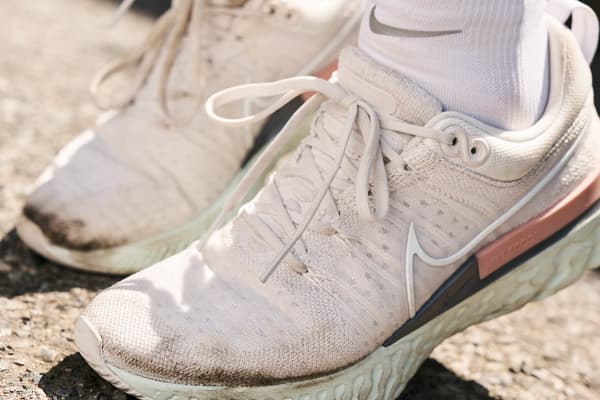What To Know About Running in the Rain — And How To Do It Safely
Sports & Activity
Follow these expert-backed tips to make running in the rain safe and enjoyable.

Picture this: You’ve just changed into your running clothes, warmed up, and are ready to hit the pavement — only to find out that it’s starting to drizzle. Should you skip your planned jog or stick to the treadmill instead of running outside? Here, experts share advice about running in the rain, and how to have fun and stay safe.
(Related: How To Warm Up Before Running, According to Experts)
“Sometimes running in the rain is the best time to go for a run,” said Stacy T. Sims, M.S.C., Ph.D., exercise physiologist, and nutrition scientist. For starters, it can be peaceful. Humans are naturally drawn to the smell of rain, a phenomenon known as petrichor. Studies have shown that this aroma helps calm the mind and regulate mood, which can serve as a stress reliever. You might even end your run more mindfully than when you started.
Plus, running is a sport you can do in most weather conditions, Sims said. Take training for a race, for example. Going for a run in the rain will not only help you keep up with your training schedule, but it’ll also prepare you for a range of weather come race day. “You never know how race day will turn out,” Sims said.
“I think that pushing yourself out of your comfort zone by running in the rain layers a different level of mental toughness,” said Alli Felsenthal, NCSF Certified Personal Trainer, UESCA Certified Running Coach, and NASM Performance Exercise Specialist. “Facing uncertainty is scary, but facing it and doing it will create both physical and mental breakthroughs in your training and your races. These are essential experiences for any runner.”
However, there are a few tips to consider before lacing up your shoes and hitting potentially slick pavement.

How To Safely Run in the Rain
While running in the rain is generally considered safe, there are some precautions to keep in mind. First and foremost, it’s important to understand that if it’s storming, lightning, or flash flooding, you should take your run indoors, Sims said. “There’s a difference between building your mental strength by running in the rain and running in dangerous conditions,” she said.
What's more, any injury becomes possible when running in off-putting conditions. “Remember the purpose behind every run and consult a friend or a coach to help you figure out a way to strategize this,” Felsenthal said. “Joint injuries, including runner's knee, plantar fasciitis, hip impingement, hamstring pull/tear, rolling your ankle, are all possible. Air on the side of caution, and if you can, go to your local gym to see if they have a day pass so you can hop on the treadmill as another alternative option.”
If you do choose to take your run outdoors, visibility is one of the most important safety measures you can take. If you’re running on the road or a sidewalk, always run against traffic and make sure drivers can see you by wearing bright neon colors with reflective paneling, Sims advised.
Running in the rain likely means running on a wet, slippery surface, which can lead to falls. Here’s what the experts say can reduce risk of injury.
Wearing the right type of shoe is essential for safety while running in the rain. Ensure that your sneakers have a lot of traction, which will help you grip the ground better and avoid slipping.
(Related: What Are the Best Nike Running Shoes for Beginners?)
Have a speed workout on the docket? You’ll probably want to reschedule that to when it’s not raining, Sims cautioned. “Rainy days are for easy runs so that you can be more aware of your surroundings and running surfaces,” she said.
“It's important to slow it down and maybe switch up a day on your training program if need be so that you can make an easy effort/conversational-paced run in the rain,” Felsenthal said.
Be sure to keep tabs on your body temperature too. Running in the rain, and being wet, increases the risk of hypothermia, a medical emergency that occurs when your body loses heat faster than it can produce heat. Ultimately, this can cause body temperatures to drop to dangerously low levels, according to Mayo Clinic.
Also note that, regardless of weather, warming up before a run is absolutely important, Sims said.
“When it rains, your body temperature may take a bit longer to warm up, so it’s especially important to warm up on days you’re running in the rain,” she said. “Warm-ups should be dynamic. You can do squats, A and B skips, and reverse lunges, for example.”
Proper Gear for Running in the Rain
To protect yourself from hypothermia, don’t wear cotton, Sims advised. “Cotton will soak up every bit of rain and moisture and may put you at risk for hypothermia and/or chafing — depending on the temperature outside.”
When it comes to chafing, wearing compression shorts and applying chafing cream could help.
(Related: Best Rainy Day Gear to Keep You Warm and Dry)
Also, opt for clothing that wicks moisture. If you’re going out on a rainy run in winter, you may want to consider wearing gear made of merino wool as it’s less chilly on your skin when wet compared to water-wicking running gear made from polyester, Sims said.
Finally, Felsenthal recommended wearing a hat with a brim to keep the rain out of your face so your visibility isn’t impaired.
Regardless of whether it’s rainy or not, you should always throw your workout clothes in the wash to avoid getting mildewy. Your shoes will get wet, so maybe opt for a pair that isn’t your racing pair, Felsenthal said. You can also try stuffing your wet shoes with newspaper to help absorb some moisture post-run. The last thing you should do is pop them in the dryer (or washing machine).
Words by Faith Brar












